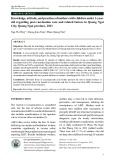
9
Journal of Health and Development Studies (Vol.08, No.01-2024)
Ngo Thi Thuy et al.
DOI: https://doi.org/10.38148/JHDS.0801SKPT23-058
ABSTRACT
Objectives: Describe the knowledge, attitudes, and practices of mothers with children under one year of
age on post-vaccination care and some related factors in Quang Ngai City, Quang Ngai province, in 2023.
Methods: A cross-sectional study, interviewing 345 mothers with children under 1-year-old in 08
communes and wards of Quang Ngai City, Quang Ngai province, from February to April 2023.
Results: Good knowledge achieved by mothers of children under one year of age on childcare after
vaccination was 62.0%. Good attitude and good practice of mothers on childcare after vaccination reached the
rate of 89.0% and 74.0%, respectively. The study found an association between the mothers’ good knowledge,
attitudes and educational level of mothers (OR=2.49 (1.58-3.91)), the mothers whose children experienced
adverse events after immunization (AEFI) (OR=2.57 (1.52-4.33)) or had siblings who had experienced
AEFI have significantly better knowledge of post-vaccination care (OR=3.74 (1.41-9.95)), the number of
communication channels also have positive influence to mother’s knowledge (OR=2.60 (1.23-5.52)).
Conclusions: Diversify forms of communication and further promote the role of health workers in
providing knowledge about the benefits of vaccination and how to detect and treat AEFI, focusing on
mothers with low levels of education.
Keywords: Knowledge, attitude, practice, adverse events after immunization.
Corresponding author: Ngo Thi Thuy
Email: tcmrquangngai2021@gmail.com
1
Center for Disease Control of Quang Ngai Province
2Hanoi University of Public Health
3
National Institute of Hygiene and Epidemiology
Knowledge, attitude, and practices of mothers with children under 1-year-
old regarding post-vaccination care and related factors in Quang Ngai
City, Quang Ngai province, 2023
Ngo Thi Thuy1*, Duong Kim Tuan2, Pham Quang Thai3
ORIGINAL ARTICLES
Submited: 15 July, 2023
Revised version received: 11 September, 2023
Published: 29 February, 2024
DOI: https://doi.org/10.38148/JHDS.0801SKPT23-058
INTRODUCTION
The vaccine in immunization is considered
safe, but the risk of adverse events after
immunization (AEFI) is a medical abnormality
that includes manifestations at the injection
site or at occurs after vaccination (1).
AEFI often occurs within the first 24 hours
following vaccination and healthcare workers
contribute significantly to vaccine safety
monitoring by being vigilant in recognizing and
reporting AEFI. Besides healthcare workers,
mothers play a vital role in early detection,
prevention, and management, reducing the
consequences of AEFI. Mothers need to
monitor their children after vaccination to
promptly identify any abnormal symptoms or
mild common reactions and quickly recognize
dangerous signs for timely intervention,
avoiding unfortunate complications and risks
(2) A study conducted by Pham Thi Ngoc
in Hai Phong City in 2021 yielded results:
There were still 12.7% of mothers who did
not keep their children for enough 30 minutes





















